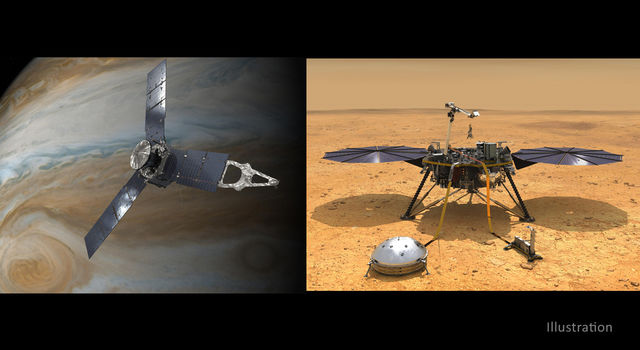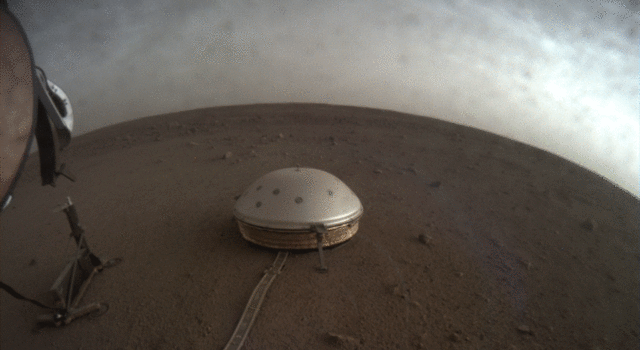Blogs | Dawn Journal | May 25, 2009
May 2009
Dear Astrodawns,
Dawn’s mission continues to go very well, as the spacecraft nears the end of the longest coasting period of its astronomical journey. The deep-space member of the team has completed more special activities under the helpful guidance of the terrestrial contingent.
The previous log described the installation of software in the spacecraft’s main computer. (Known as flight software 8.0, this name was chosen as part of Dawn’s new outreach effort to increase public awareness of the number 8. Please consider yourself aware. The outreach plan for the designation of the subsequent version of the software is expected to be 12.5% better.) The software had been tested extensively in simulators on Earth, but the ultimate test is its performance in keeping the spacecraft running smoothly. Because Dawn devotes more time in space to thrusting with its ion propulsion system than doing anything else (this does not count the time it spends in eager anticipation of the exciting rewards to be garnered at its destinations Vesta and Ceres), it was important to verify that the capability to thrust was not compromised with the new software. Despite the assiduity with which 8.0 was developed, the possibility of a subtle bug being introduced could not be discounted.
A test well ahead of the planned resumption of thrusting early in June would allow time to rectify problems and still keep to the itinerary. Just as with the tests in the initial checkout phase of the mission, the objective was to show that all subsystems would work together (under control of the new software) to sustain stable thrusting.
On April 27, as it had done so many times earlier in the mission, the spacecraft executed a set of commands to rotate to point a thruster in a selected direction, perform the pre-start procedures, and undertake powered flight. With tests during the initial checkout phase plus all the thrusting in the interplanetary cruise phase designed to reshape the probe’s orbit around the Sun, Dawn had accumulated 123 days of operation with ion thruster #1 and 158 days with ion thruster #3. (The locations of the thrusters are explained in a previous log.) Thruster #2 has not had its turn yet for long-term thrusting, so it had been operated only for 22 hours. While much longer than the operating time for a propulsion system on a typical planetary spacecraft, for Dawn this is still considered brand new. Therefore, the 8.0 system thrust test used ion thruster #2, allowing it to accelerate xenon for the first time since November 16, 2007.
After thrusting for 4 hours, the spacecraft stopped and reoriented itself, aiming the main antenna to Earth again. On May 1, it conducted a similar exercise, differing only in the direction of thrust. These tests provided the final confirmation that 8.0 was ready to take the helm when the time came to resume propelling the craft to the asteroid belt.
These activities had a secondary benefit. During the initial checkout phase, some tests were conducted of how accurately thrusters #1 and #3 could be pointed. The equivalent test with #2 could not be run then because the spacecraft was too close to the hot Sun to point that thruster in the required direction, so it was planned for April 2008. That operation was interrupted by an event that led to safe mode being invoked. Because thruster #2 was not scheduled to be used until much later in the mission, the test was postponed to the coast period after Mars. The 8.0 system thrust verification test was executed in the directions needed to complete the thruster #2 pointing tests, thus accomplishing these additional objectives.
Thrusting at this time in the mission does not help reach the targets (if it did, Dawn would not spend so much time coasting), but the short thrust trials did not modify the trajectory appreciably. The ion propulsion system has changed the spacecraft’s speed by about 1.87 kilometers per second (4180 miles per hour) so far in the mission, and this latest work added only 2.3 meters per second (5.1 miles per hour) to the total.
Following these successful tests as well as several weeks of other operations, engineers were sufficiently pleased with 8.0’s admirable performance in both its software and its outreach functions that they were ready to commit to using it. In April, the software had been installed only in the primary location in the primary computer. On May 11, mission controllers powered on the backup computer and installed the primary and backup copies of 8.0. On May 13, they loaded the software to the backup area of the primary computer, so now 4 copies of 8.0 are stored onboard. Updating the software, even in a backup location, is a delicate operation, but all the procedures went according to plan. That brought the work on 8.0 to a successful and satisfying conclusion.
For the ion propulsion system to operate with its extraordinary efficiency, a gentle flow of xenon gas to the thruster needs to be accurately controlled. At full throttle, this amounts to slightly more than 3 milligrams per second (less than 10 ounces per day), and by the end of the mission, when limited electrical power necessitates a low throttle level, the flow will be reduced to less than 40% of that rate. A sophisticated labyrinth of tubes, electronically controlled valves, and other components feeds the propellant from the main tank to the selected thruster. Along the way, xenon is held temporarily in a pair of small, low-pressure tanks (each known as a “plenum” and the pair as “plena”). The main tank is pressurized to more than 1000 pounds per square inch (psi, and note we will spare readers the metric units for pressure), but one of the plena is charged to less than 67 psi and the other is never raised above 37 psi. Pressures will be still lower at lower throttle levels.
The ion propulsion system’s computer controller relies on pressure and temperature sensors on each plenum as it regulates the flow of xenon. The controller interprets any change in the pressure as a change in the amount of gas moving through the system, so a shift in the behavior of a sensor would cause the controller to adjust the rate at which xenon is delivered to the operating thruster.
The pressure sensors are designed to remain stable throughout the mission, but in order to keep the ship in good shape, ever-skeptical engineers want to determine how much (if at all) the devices have drifted in their measurements since they were calibrated well before launch. So here they are confronted with a conundrum: how can they verify the sensors on the distant spacecraft are giving accurate readings?
We solicit here ideas from readers for how to accomplish this “plenum pressure transducer calibration.” Please submit your ideas to the Dawn project before the next paragraph is written, and the best idea will be implemented. What a thrilling reward that will be for some lucky reader! Be sure to include thorough calculations, assessment of risks to the spacecraft and mitigations for those risks, a complete list of commands, predictions for subsystem telemetry, and any other pertinent details.
Thank you very much to all those who proffered suggestions; we received a surprising number of innovative methods, a few of which are even compatible with physical laws and the capabilities of the Dawn spacecraft. We now have an effective solution. (The winning entry came from a reader on Earth who does not want the prestige of being named here, but we offer our most sincere congratulations!)
By bringing the plena to a pressure that is ascertained without the use of the pressure sensors, engineers can compare the sensor readings with the independently determined pressures. So they commanded certain valves to open, thus allowing the xenon in these tanks to vent into space. Each plenum will evacuate to nearly 0 psi, so the report from the pressure sensors will provide a direct measurement of how much their behavior has changed, and any discrepancy can be accounted for by straightforward updates to the software.
The procedure of connecting the plena to the cosmic vacuum is known as a blowdown, perhaps connoting a gale-force wind of xenon as it begins rushing out of the system. The reality is somewhat different. When the valves were opened on May 4, the force from the zephyr of xenon leaving the spacecraft was less than 3% of the famously light thrust achieved when the xenon is ionized and accelerated at full throttle. The unionized xenon pushed on the spacecraft with about one tenth of the force you would feel holding a penny. As the plena pressures fell, the force diminished still further.
At the conclusion of the 8.0 system thrust test, one plenum held 90 grams (about 3 ounces) of gas and the other held 50 grams (less than 2 ounces). (For comparison, the main tank carried 425 kilograms, or 937 pounds, at launch and now holds 350 kilograms, or 772 pounds.) The expenditure of this small amount (about what is used in half a day of thrusting at maximum throttle level) is well within the mission’s overall xenon budget. The valves will be left open for several weeks to allow plenty of time for the xenon to find its way from the plena through the maze of hardware to space. Well before thrusting begins on June 8, the valves will be closed and the plena repressurized.
In the meantime, Dawn will pass another milestone in its solar system adventure. As we have seen in previous logs, the nature of orbits is that at greater distances, objects travel more slowly. Dawn and Earth both orbit the Sun, but the spacecraft, being more remote than the planet, travels more slowly. On June 3, Dawn will complete its first revolution around the Sun (a “Dawn year”) since its September 27, 2007 launch. Earth, along with its residents (constituting a small but enthusiastic fraction of our readership) as well as the moon and all other natural and human-made satellites in orbit around it, needs about 365 days for a revolution, so it will have made 1.68 loops while Dawn was in its first.
You may be tempted to think that Dawn takes longer to round the Sun than Earth because it has to travel a greater distance to do so in its larger orbit, but you are encouraged not to yield to this simple explanation. Earth has moved more than 1.58 billion kilometers (984 million miles) since letting go of the probe. In the same time, Dawn has traveled only 1.32 billion kilometers (817 million miles). When farther from the Sun, objects travel more slowly because the gravitational pull they need to resist is weaker. As it climbs atop its ion beam to still greater heights, Dawn will go even more slowly as it seeks to match orbits with its more remote destinations. Since the spacecraft departed from Earth, Vesta has completed only 0.44 revolutions, traveling 1.00 billion kilometers (622 million miles), and even more distant Ceres has made only 0.40 loops, covering 994 billion kilometers (617 million miles).
To keep our subscription fees low, we include here another subtle product placement for one of the many clocks in the Dawn gift shop, several of which have been featured in logs over the past 5 months. On this model, the Sun is at the center and there is a separate hand for each of these orbiting objects. Although they were not aligned at launch, suppose they were, with each hand pointed toward the 12. (Because of the northern hemisphere perspective with which astronomy was developed on Earth, our standard view of the solar system depicts the orbits going counterclockwise. Here we will ignore that familiar perspective, as our focus is on how many rounds each body completes, not the direction of their travel.) Since launch, Earth would have gone all the way around once and continued on clockwise to just past the 8. The spacecraft will return exactly to the 12 on June 3. Vesta will have leisurely advanced just beyond the 5, and Ceres will not quite have made it even to that number yet.
As Dawn continues to push outward from the Sun, with its sights set on alien worlds deep in the asteroid belt, we hope readers will continue to follow its progress. With (some of) the profits from the first Dawn Ponzi fund, we have added RSS feeds for these logs and other features at the Dawn website. To learn more, and to be among the first of your species to subscribe to automatic updates, visit http://dawn.jpl.nasa.gov/RSS/index.asp.
Dawn is 305 million kilometers (189 million miles) from Earth, or 845 times as far as the moon and 2.01 times as far as the Sun. Radio signals, traveling at the universal limit of the speed of light, take 34 minutes to make the round trip.
Dr. Marc D. Rayman
7:00 am PDT May 25, 2009
TAGS:DAWN, VESTA, CERES, DWARF PLANET, MISSION, SPACECRAFT







